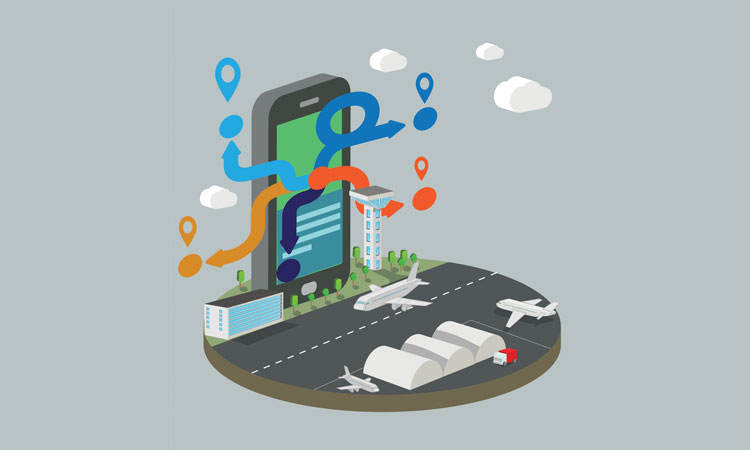Passenger experience supplement: Seamless strategies
- Like
- Digg
- Del
- Tumblr
- VKontakte
- Buffer
- Love This
- Odnoklassniki
- Meneame
- Blogger
- Amazon
- Yahoo Mail
- Gmail
- AOL
- Newsvine
- HackerNews
- Evernote
- MySpace
- Mail.ru
- Viadeo
- Line
- Comments
- Yummly
- SMS
- Viber
- Telegram
- Subscribe
- Skype
- Facebook Messenger
- Kakao
- LiveJournal
- Yammer
- Edgar
- Fintel
- Mix
- Instapaper
- Copy Link
Posted: 1 September 2016 | Konrad Best, Michael Zaddach | No comments yet
‘Seamless travel’ is considered one of five strategic fields of action at Munich Airport. Senior Vice President and CIO, Michael Zaddach and Vice President of Digital, Konrad Best, reveal how the two business divisions of information technologies and corporate strategies work closely together in planning and realising the airport’s ‘digital journey’ to be prepared for the future.


Seamless travel concepts focusing on efficient and comfortable travel experiences for passengers will play an increasing and essential role for all leading high-quality airports going forward. Providing a stress-free and smooth travel chain is a corporate-wide project that involves numerous airport divisions and external partners. Nearly all airport divisions are invited to contribute with forward-looking input and trendsetting ideas.
The main objectives are to provide necessary information to the passengers, make travel processes smoother and more transparent, and enhance the quality and satisfaction for the travellers. This shall be achieved through digital connectivity alongside the customer journey. This work will also enable us to collect more information about the passengers and their preferences to set up new communication channels and make the right customer offers at the right time so that non-aviation revenues will hopefully get a further boost. It is vital to ensure that both components – revenues and customer satisfaction – are carefully balanced out.
To coordinate the customer journey from a single source – the airport – you need to link and interface the services of other service providers, authorities and travel industry partners. The big challenge is to coordinate the interests of all partners involved, evaluate and manage synergies.
From an IT perspective it is necessary to provide a platform or infrastructure to interface diverse systems of external partners, such as airlines, railways, parking services, taxis and car rental companies, with our own corporate systems such as SAP, CMS, CRM, POS or different aviation systems i.e. AOOB, baggage, lounges. The channel for passengers will be Munich
Airport’s app, its website and other digital channels of the airport’s partners.
Mobile devices open up new information and sales channels. In summary, what we’re hoping to achieve through various digital channels is personalised relevant information, efficient processes, a relaxing experience for passengers at the airport and greater revenues for the airport itself. It’s a win-win situation; when you provide individual travel information and customised service offers in real-time it will become much easier and passengers will then make better use of their departure, arrival or transit time.
Seamless travel in the future may include information such as navigation, public transportation, flight data and delays, gate changes, waiting times at security and passport controls, weather conditions, retail and shop offers, vouchers or wellness and entertainment choices. But it can also comprise all kinds of bookable services such as parking, shopping assistance, lounges, meet and greet or VIP services and support for the physically challenged.
Munich Airport’s former app was a simple information channel. Our new app has developed into a ‘dialogue media’, which is exactly what is needed nowadays. Mobile devices have already found their way into airports in the form of self-check-in or quick-boarding. More and more passengers communicate online with us through the different social media channels. The mobile device has become a constant companion when travelling and the digital development at airports has logically taken off for its journey into the future.
To this end, ‘Passngr’ App – a joint venture between Munich, Hamburg and Düsseldorf Airports – was recently launched. The idea behind this cooperation was to pool resources from the three major German airports to provide information and a full service from the starting point to the final destination of the trip, resulting in ‘one app for all’, from one single source.
Passenger needs and demands have changed massively compared to the past. Overall attendance and support during the complete trip, beyond the airport, is now appreciated, especially when unscheduled incidents occur. With Passngr, the communication and contact starts only on the passenger’s request, and is personalised and professional. The app intends to be a reliable partner and helper for all situations and ensures no other apps are needed during the trip; guaranteeing a smoother user experience (Case Study below).
While the participating airports still have their freedom regarding their branding, layout and content, the costs for development, operation and updates are being shared. Passngr was launched with basic features and will steadily continue to develop and improve services. The participating airports now have the opportunity for professional tracking leading to a simplified monitoring of performance and optimised service offers. Collecting user data helps to improve offering adequate services when and where needed by the client. This joint project bundles forces and resources while increasing business value.
The mission statement of Passngr is ‘Let’s go forward’. Cooperation among German airports was just the take-off – the future vision is in a second step to include further European airports and in a third step even worldwide airports, always with an eye to giving best service and comfort to our passengers.
Passngr App Case Study
Mr Hansen is flying for business from Hamburg to New York and transits at Munich Airport. How does Passngr help him?
- Mr Hansen downloaded Passngr before his trip and agreed to the push message service
- From home, Mr Hansen booked his car parking via Passngr
- Upon entering Hamburg Airport Mr Hansen automatically receives a message to say his gate number has changed – he proceeds to that gate
- As his connecting flight in Munch is six hours later, he is offered the chance to book lounge access at Munich Airport or to store his luggage in order to book on an airport visitor’s tour – from Hambug Mr Hansen books lounge access at Munich Airport using Passngr
- Upon arrival in Munich the personal shuttle to the lounge awaits him. He can relax because he will receive any possible changes regarding his flight direct to the app
- While drinking his coffee in the lounge he realises, via Passngr, that there is an offer for free dessert at a restaurant close to his departure gate – he opens the coupon in the app and redeems the voucher in the restaurant
- Mr Hansen is at ease knowing he won’t have to keep constant track of the time as the app will remind him when it’s time to board his aircraft.
Biographies
Michael Zaddach has been Senior Vice President and CIO at Flughafen München GmbH since 2000. His area of responsibility covers system development, system operation, and the whole IT infrastructure of Munich airport. After completing a university degree in communications engineering he worked at Siemens, AEG and debis Systemhaus in various capacities and several management functions. At debis Systemhaus he led a business unit for IT consulting services. As a head of that unit he conducted several outsourcing projects of debis Systemhaus. He is also the Chair of the ADV IT Committee and the Vice Chair of the ACI World Airport IT Standing Committee.
Konrad Best started his career as an entrepreneur in the media business in the early 1990s, founding an independent record company for electronic music. In 2004 he went into the telecommunication business, working in the B2C division of Telefonica O2 Germany in several leading positions. His next position was Director for Offers and Content at the video on demand platform Maxdome before he went to the telecommunication company M-net in Munich. As Vice President of Digital at Munich Airport, a position he has held since the beginning of 2016, Konrad is responsible for the airport’s digital B2C strategy.
Issue
Related topics
Information technology (IT), New technologies, Passenger experience and seamless travel, Terminal operations


















